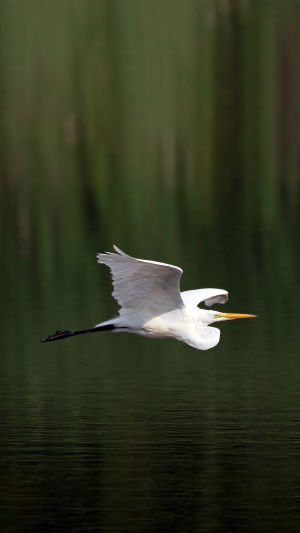Egrets are some of the world's most striking and rare coastal ornamental birds and are a crucial indicator of the health of wetland environments. They possess high plumage value, with mostly white feathers and long, decorative nuptial plumage during the breeding season.
Their habits are similar to those of other herons, but some species engage in courtship displays, such as displaying their plumage. They nest in large flocks and are defenseless, making them vulnerable to indiscriminate human predation.
Egrets build large, messy nests in trees, shrubs, or on the ground. They primarily feed on a variety of small fish, but also consume animal foods such as shrimp, crabs, tadpoles, and aquatic insects. They typically stroll along riversides, salt flats, or paddy fields, pecking at their food as they go. Their long beaks, necks, and legs make it easier for them to hunt for food in the water.
When feeding, egrets gracefully wade through the water and stroll forward, keeping their eyes on small animals in the water. They suddenly peck at the water with their long beaks, accurately capturing their prey and bringing it to their mouths. They also often stand at the water's edge, waiting for an opportunity to catch passing fish.
Egrets breed from May to July each year, nesting on islands near the coast and on rocks or in the branches of small trees on coastal cliffs. They prefer to nest in groups. Some nests have been found in close proximity to each other, with one group of 14 nests found on a rocky outcropping of only 20 square meters and another group of 11 nests found on an adjacent rock of only 10 square meters.
The nests are shallow, saucer-shaped, and constructed mainly of dead grass stems and leaves.
The yellow-billed egret is the most valuable species of an egret. It has a body length of 46-65 cm and weighs 320-650 grams. It has an elegant posture and is clothed in immaculate white feathers. However, its plumage color varies greatly during different seasons. In the summer, its beak is orange-yellow, its feet are black, its toes are yellow, and its eyes are blue.
In the winter, its beak turns dark brown, the base of its lower beak is yellow, and its eyes are yellow-green. The yellow-billed egret breeds mainly in Korea, South Korea, and eastern China, and winters mainly in the Philippines, Malay Peninsula, Singapore, Sumatra, and Vietnam.
It is listed as an endangered species in the Red Book of World Endangered Birds by the International Council for Bird Protection. It is a very precious bird.





